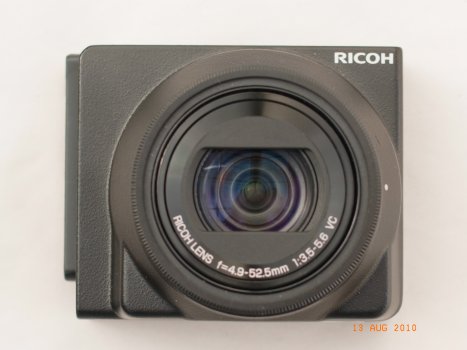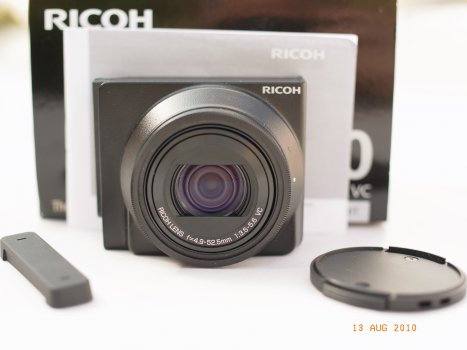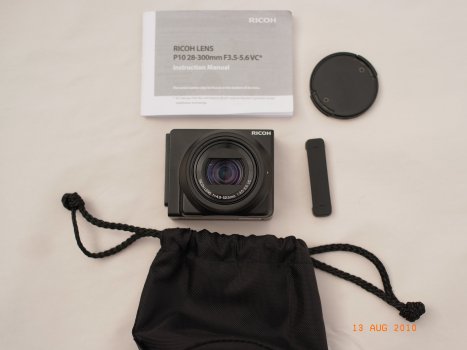 As you may remember, some months ago we reviewed the new modular Ricoh GXR semi professional camera with quite good results.
As you may remember, some months ago we reviewed the new modular Ricoh GXR semi professional camera with quite good results.

Assessment
This is number three of the available interchangeable lens-sensor modular units put out by Ricoh for its GXR camera. The P10 features a high-magnification 10.7x (28-300 mm) optical wide-angle zoom and high-speed continuous shooting of RAW still images at approximately 5 frames/second. Note that continuous shooting speed will vary depending on shooting conditions, card type, card condition, etc. (4 M-Continuous Plus (Low) image size is fixed at 10M 4:3N and 5 M-Continuous Plus (Hi) image size is fixed at 2M 4:3N.)

The consecutively shot images are recorded as single MP files (a file format with multiple still images in a single file). The P10 also has an advanced noise reduction function, with a back illuminated CMOS sensor to give superior imaging in low light photography. The image processing engine (Smooth Imaging Engine IV) is coupled to the high-speed image processing capabilities of the CMOS sensor and combines to enhance image quality and expand dynamic range. The 10.7 x optical zoom expands image possibilities from a wide-angle through to telephoto. Included features such as 1280 x 720 pixel HD movie taking, dynamic range double shot mode and macro at a distance of 1cm, all add to the versatile nature of this lens.
We found that the camera lens performed a little above the average with regards to white balance, focus and colour reproduction and was marginally ahead of its rivals with regards to effective noise reduction. It was worth noting, however, that some of the fine detail in photographs taken in low light situations did appear to suffer. The P10’s 28 mm wide-angle to 300 mm telephoto lens option provides a versatile high-magnification zoom lens that can handle a wide range of shooting situations. There is also a zoom function for changing to high-speed by continued pressing of the zoom lever. This is a lens that can handle both wide-angle shooting of expansive landscapes and interior scenes with limited distances between the camera and the subject.
Ricoh’s GXR idea of providing a modular concept to match lens suitability to the subject’s situation in order to optimise photographs is still unique and is yet to be successfully duplicated by any rivals.
Specifications
RICOH LENS P10 28-300 mm F3.5-5.6 VC
|
Item |
Specifications |
|||
|
Effective pixels |
Approximately 10 million |
|||
|
Image sensor |
1/2.3-inch CMOS sensor (total pixels: approx. 10.60 million pixels) |
|||
|
Lens |
Focal length |
f=4.9-52.5 mm (35 mm equivalent: 28-300 mm) |
||
|
Aperture (F-number) |
f/3.5 – f/5.6 |
|||
|
Focus range (from the front of the lens) |
Normal shooting: Approx. 30 cm – infinity (wide-angle), approx. 1.5 m – infinity (telephoto) |
|||
|
Macro shooting (from the front of the lens) |
Approx. 1 cm – infinity (wide-angle), approx. 27 cm – infinity (telephoto), approx. 1 cm – infinity (zoom macro) |
|||
|
Construction |
10 elements in 7 groups (4 aspherical lens elements with 5 surfaces) |
|||
|
Zoom |
10.7× optical zoom; 4.0× digital zoom (2.8x for movies, HD), approx. 5.7× auto resize zoom (VGA) |
|||
|
Focus mode |
Multi AF; Spot AF; MF: Snap; ∞; Multi-trgt AF (AF auxiliary light and focus bracketing available) |
|||
|
Camera shake correction function |
Image sensor shift method image stabiliser |
|||
|
Shutter speed |
Photographs |
1/2000 – 30 s (upper and lower limits vary according to shooting and flash mode) |
||
|
Movies |
1/30 – 1/2000 s |
|||
|
Exposure control |
Metering |
Multi (256-segment), centre-weighted, and spot modes (TTL metering with auto exposure lock) |
||
|
Mode |
Program AE, aperture priority AE*1, manual exposure, shutter, priority AE, move target function |
|||
|
Exposure compensation |
Manual (+4.0 to -4.0 EV in increments 1/3 EV or 1/2 EV), auto bracketing (-2 EV to +2 EV in increments 1/3 EV or 1/2 EV) |
|||
|
ISO sensitivity (Standard Output Sensitivity) |
Auto, Auto-Hi, ISO 100, ISO 200, ISO 400, ISO 800, ISO 1600, ISO 3200 |
|||
|
White balance |
Auto / Multi-P AUTO / Outdoors / Cloudy / Incandescent Lamp 1 / Incandescent Lamp 2 / Fluorescent Lamp / Manual Settings / Detail; white balance Bracketing |
|||
|
Flash |
Range (built-in flash) |
Approx. 20 cm – 4.0 m (wide-angle), approx. 28 cm – 2.5 m (telephoto) (ISO AUTO) |
||
|
Shooting mode |
Auto / program shift / aperture priority*1 / shutter priority / manual /scene (movie, portrait, sports, landscape, nightscape, skew correction, dynamic range double shot, zoom macro) / “My Settings” |
|||
|
Continuous mode |
Number of pictures shot in Continuous (Picture Size: RAW) |
Noise Reduction off: 5 pictures; Noise Reduction on weak, strong, or MAX: 4 pictures |
||
|
Number of pictures shot in M-Cont Plus (1 set) |
Low (3648 × 2736): 15 pictures (5 frames/sec.), Hi (1728 × 1296): 26 pictures (30 frames/sec.) |
|||
|
Number of pictures shot in Ultra-high-speed Cont (1 set) |
Low (640 × 480): 120pictures (60 frames/sec.), Hi (640 × 480): 120 pictures (120frames/sec.) |
|||
|
Picture quality*2 |
FINE, NORMAL, RAW (DNG)*3 |
|||
|
Image size (pixels) |
Photographs |
16:9 |
3648 x 2048, 3264 x 1840 |
|
|
4:3 |
3648 x 2736, 3264 x 2448, 2592 x 1944, 2048 x 1536, 1280 x 960, 640 x 480 |
|||
|
3:2 |
3648 × 2432, 3264 × 2176 |
|||
|
1:1 |
2736 x 2736, 2448 x 2448 |
|||
|
Movies |
1280 × 720, 640 × 480, 320 × 240 |
|||
|
File size (approx.) |
RAW |
16:9 |
NORMAL: 12,923 KB/frame, |
|
|
4:3 |
NORMAL: 17,202 KB/frame, |
|||
|
3:2 |
NORMAL: 15,311 KB/frame, |
|||
|
1:1 |
NORMAL: 12,956 KB/frame, |
|||
|
L |
16:9 |
NORMAL: 1,630 KB/frame, |
||
|
4:3 |
NORMAL: 2,169 KB/frame, |
|||
|
3:2 |
NORMAL: 1,930 KB/frame, |
|||
|
1:1 |
NORMAL: 1,633 KB/frame, |
|||
|
M |
16:9 |
NORMAL: 1,329 KB/frame, |
||
|
4:3 |
NORMAL: 1,761 KB/frame, |
|||
|
3:2 |
NORMAL: 1,567 KB/frame, |
|||
|
1:1 |
NORMAL: 1,327 KB/frame, |
|||
|
5M |
4:3 |
FINE: 2,287 KB/frame |
||
|
3M |
4:3 |
FINE: 1,474 KB/frame |
||
|
1M |
4:3 |
FINE: 812 KB/frame |
||
|
VGA |
4:3 |
FINE: 197 KB/frame |
||
|
Battery life |
Based on CIPA standard DB-90: approx. 440 shots )*4 |
|||
|
Dimensions (W x H x D) |
Camera unit only |
68.7 mm × 57.9 mm × 44 mm (according to CIPA guidelines) |
||
|
When mounted on the GXR body |
113.9 mm × 70.2 mm × 49.8 mm (according to CIPA guidelines) |
|||
|
Weight |
Camera unit only |
160 g (not including the lens cap or connector cap) |
||
|
When mounted on the camera body |
367g (including battery, SD memory card, and lens cap) |
|||
|
Operating temperature |
0°C to 40°C |
|||
|
Operating humidity |
85% or less |
|||
|
Storage temperature |
-20°C to 60°C |
|||
|
|
||||
|
Explanation Grid |
||||
|
*1 |
ND filter used for aperture priority AE aperture priority mode. |
|||
|
*2 |
The picture quality modes which can be set vary depending on the image size. |
|||
|
*3 |
A JPEG file is also recorded (the JPEG file may be a FINE- or NORMAL-quality file with the same dimensions as the RAW file or a VGA file 640 × 480 pixels in size). RAW files use the standard DNG format promoted by Adobe Systems Incorporated. |
|||
|
*4 |
For reference only; actual number of shots varies greatly according to how camera is used. We recommend that you carry spare batteries when in use for extended periods. (Shooting capacity was measured using CIPA-standard parameters. These are only estimates; performance may vary depending on usage conditions.) |
|||
Conclusion
We continue to be impressed by the Ricoh add ons and particularly like the fact that the menus and operational principles remain the same as you simply add on more specific sophisticated purpose lenses. This, of course negates the need to having to relearn camera operation as you would have to do if you upgraded your camera in any other brand.
We think that at an approximate cost of $499 Aud for the lens it represents good buying to gain another enhancement to optimise your photography skills and camera versatility.


